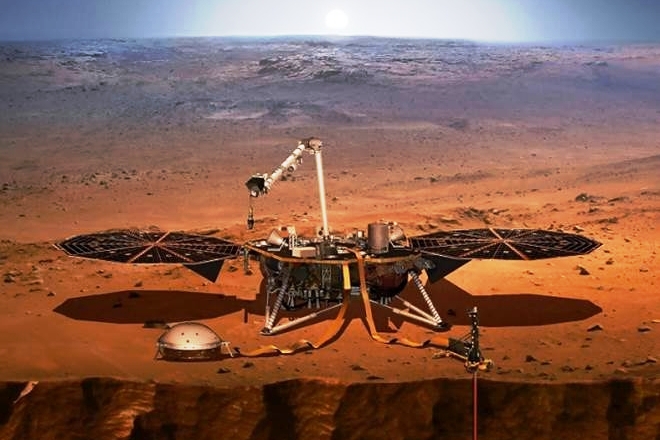Washington: Elysium Planitia, the site chosen for the November 26 landing of NASA’s InSight mission to Mars, is so plain that it may very well look like a stadium parking lot, the US space agency has said.
“If Elysium Planitia were a salad, it would consist of romaine lettuce and kale – no dressing,” said InSight principal investigator Bruce Banerdt at NASA’s Jet Propulsion Laboratory (JPL) in Pasadena, California.
“If it were an ice cream, it would be vanilla.”
But that is the way the Interior Exploration using Seismic Investigations, Geodesy and Heat Transport (InSight) project likes it.
“Previous missions to the Red Planet have investigated its surface by studying its canyons, volcanoes, rocks and soil,” said Banerdt.
“But the signatures of the planet’s formation processes can be found only by sensing and studying evidence buried far below the surface. It is InSight’s job to study the deep interior of Mars, taking the planet’s vital signs — its pulse, temperature and reflexes,” Banerdt added.
Taking those vital signs will help the InSight science team look back to a time when the rocky planets of the solar system formed. The investigations will depend on three instruments:
A six-sensor seismometer called the “Seismic Experiment for Interior Structure” (SEIS) will record seismic waves travelling through the interior structure of the planet. Studying seismic waves will tell scientists what might be creating the waves.
Mars, scientists suspect that the culprits may be marsquakes or meteorites striking the surface.
The mission’s “Heat Flow and Physical Properties Package” will burrow deeper than any other scoop, drill or probe on Mars before to gauge how much heat is flowing out of the planet. Its observations will shed light on whether Earth and Mars are made of the same stuff.
Finally, InSight’s “Rotation and Interior Structure Experiment” (RISE) will use the lander’s radios to assess the wobble of Mars’ rotation axis, providing information about the planet’s core.
For InSight to do its work, the team needed a landing site that checked off several boxes, because as a three-legged lander — not a rover — InSight will remain wherever it touches down.
“For the first time ever, the evaluation for a Mars landing site had to consider what lay below the surface of Mars,” said Tom Hoffman, InSight project manager at JPL.
“We needed not just a safe place to land, but also a workspace that’s penetrable by our 16-feet-long (five metre) heat flow probe,” Hoffman added.
The site also needs to be bright enough and warm enough to power the solar cells while keeping its electronics within temperature limits for an entire Martian year (26 Earth months).
So the team focused on a band around the equator, where the lander’s solar array would have adequate sunlight to power its systems year-round.
After a 205-day journey that began on May 5, NASA’s InSight mission will touch down Mars November 26.
Its solar panels will unfurl within a few hours of touchdown.
Mission engineers and scientists will take their time assessing their “workspace” prior to deploying SEIS and Heat Flow and Physical Properties Package on the surface — about three months after landing — and begin the science in earnest, NASA said.
IANS
